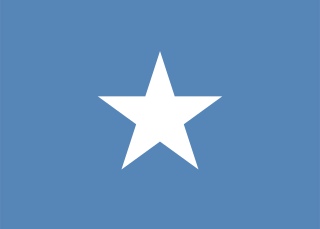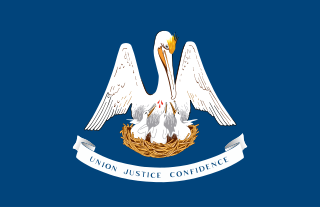
The Louisiana Purchase was the acquisition of the territory of Louisiana by the United States from the French First Republic in 1803. This consisted of most of the land in the Mississippi River's drainage basin west of the river. In return for fifteen million dollars, or approximately eighteen dollars per square mile, the United States nominally acquired a total of 828,000 sq mi in Middle America. However, France only controlled a small fraction of this area, most of which was inhabited by Native Americans; effectively, for the majority of the area, the United States bought the preemptive right to obtain Indian lands by treaty or by conquest, to the exclusion of other colonial powers.

The Adams–Onís Treaty of 1819, also known as the Transcontinental Treaty, the Spanish Cession, the Florida Purchase Treaty, or the Florida Treaty, was a treaty between the United States and Spain in 1819 that ceded Florida to the U.S. and defined the boundary between the U.S. and Mexico. It settled a standing border dispute between the two countries and was considered a triumph of American diplomacy. It came during the successful Spanish American wars of independence against Spain.

West Florida was a region on the northern coast of the Gulf of Mexico that underwent several boundary and sovereignty changes during its history. As its name suggests, it was formed out of the western part of former Spanish Florida, along with lands taken from French Louisiana; Pensacola became West Florida's capital. The colony included about two thirds of what is now the Florida Panhandle, as well as parts of the modern U.S. states of Louisiana, Mississippi, and Alabama.

Pinckney's Treaty, also known as the Treaty of San Lorenzo or the Treaty of Madrid, was signed on October 27, 1795, by the United States and Spain.

The Territory of Orleans or Orleans Territory was an organized incorporated territory of the United States that existed from October 1, 1804, until April 30, 1812, when it was admitted to the Union as the State of Louisiana.

The District of Louisiana, or Louisiana District, was an official and temporary United States government designation for the portion of the Louisiana Purchase that had not been organized into the Territory of Orleans or "Orleans Territory". The district officially existed from March 10, 1804, until July 4, 1805, when it was organized as the Louisiana Territory.

The territory of the United States and its overseas possessions has evolved over time, from the colonial era to the present day. It includes formally organized territories, proposed and failed states, unrecognized breakaway states, international and interstate purchases, cessions, and land grants, and historical military departments and administrative districts. The last section lists informal regions from American vernacular geography known by popular nicknames and linked by geographical, cultural, or economic similarities, some of which are still in use today.

The Perdido River, also historically known as Rio Perdido or by its native name of Cassaba, is a 65.4-mile-long (105.3 km) river in the U.S. states of Alabama and Florida; the Perdido, a designated Outstanding Florida Waters river, forms part of the boundary between the two states along nearly its entire length and drains into the Gulf of Mexico. During the early 19th century it played a central role in a series of rotating boundary changes and disputes among France, Spain, Great Britain, and the United States.

The Florida Parishes, on the east side of the Mississippi River—an area also known as the Northshore or Northlake region—are eight parishes in the southeastern portion of the U.S. state of Louisiana.

Louisiana or French Louisiana was an administrative district of New France. In 1682 the French explorer René-Robert Cavelier, Sieur de la Salle erected a cross near the mouth of the Mississippi River and claimed the whole of the drainage basin of the Mississippi River in the name of King Louis XIV, naming it "Louisiana". This land area stretched from the Great Lakes to the Gulf of Mexico and from the Appalachian Mountains to the Rocky Mountains. The area was under French control from 1682 to 1762 and in part from 1801 (nominally) to 1803.

The Republic of West Florida, officially the State of Florida, was a short-lived republic in the western region of Spanish West Florida for just over 2+1⁄2 months during 1810. It was annexed and occupied by the United States later in 1810; it subsequently became part of Eastern Louisiana.

The West Florida Controversy included two border disputes that involved Spain and the United States in relation to the region known as West Florida over a period of 37 years. The first dispute commenced immediately after Spain received the colonies of West and East Florida from the Kingdom of Great Britain following the American Revolutionary War. Initial disagreements were settled with Pinckney's Treaty of 1795.
The Mobile District was an administrative division of the Spanish colony of West Florida, which was claimed by the short-lived Republic of West Florida, established on September 23, 1810. Reuben Kemper led a small force in an attempt to capture Mobile from the Spanish on behalf of the new republic, but the expedition ended in failure.
Three Flags Day commemorates March 9, and 10, 1804, when Spain officially completed turning over the Louisiana colonial territory to France, who then officially turned over the same lands to the United States, in order to finalize the 1803 Louisiana Purchase.

Louisiana, or the Province of Louisiana, was a province of New Spain from 1762 to 1801 primarily located in the center of North America encompassing the western basin of the Mississippi River plus New Orleans. The area had originally been claimed and controlled by France, which had named it La Louisiane in honor of King Louis XIV in 1682. Spain secretly acquired the territory from France near the end of the Seven Years' War by the terms of the Treaty of Fontainebleau (1762). The actual transfer of authority was a slow process, and after Spain finally attempted to fully replace French authorities in New Orleans in 1767, French residents staged an uprising which the new Spanish colonial governor did not suppress until 1769. Spain also took possession of the trading post of St. Louis and all of Upper Louisiana in the late 1760s, though there was little Spanish presence in the wide expanses of what they called the "Illinois Country".

Feliciana Parish, or New Feliciana, French: Paroisse de Félicianne, was a parish of the Territory of Orleans and the state of Louisiana, formed in 1810 from West Florida territory. Given an increase in population, it was divided in 1824 into East Feliciana Parish and West Feliciana Parish.

The following outline is provided as an overview of and topical guide to the U.S. state of Louisiana:
The Patriot War was an attempt in 1812 to foment a rebellion in Spanish East Florida with the intent of annexing the province to the United States. The invasion and occupation of parts of East Florida had elements of filibustering, but was also supported by units of the United States Army, Navy and Marines, and by militia from Georgia and Tennessee. The rebellion was instigated by General George Mathews, who had been commissioned by United States President James Madison to accept any offer from local authorities to deliver any part of the Floridas to the United States, and to prevent the reoccupation of the Floridas by Great Britain. The rebellion was supported by the Patriot Army, which consisted primarily of citizens of Georgia. The Patriot Army, with the aid of U.S. Navy gunboats, was able to occupy Fernandina and parts of northeast Florida, but never gathered enough strength to attack St. Augustine. United States Army troops and Marines were later stationed in Florida in support of the Patriots. The occupation of parts of Florida lasted over a year, but after United States military units were withdrawn and Seminoles entered the conflict, the Patriots dissolved.

The history of U.S. foreign policy from 1801 to 1829 concerns the foreign policy of the United States during the presidential administrations of Thomas Jefferson, James Madison, James Monroe, and John Quincy Adams. International affairs in the first half of this period were dominated by the Napoleonic Wars, which the United States became involved with in various ways, including the War of 1812. The period saw the U.S. double in size, gaining control of Florida and lands between the Mississippi River and the Rocky Mountains. The period began with the First inauguration of Thomas Jefferson in 1801. The First inauguration of Andrew Jackson in 1829 marked the start of the next period in U.S. foreign policy.
















